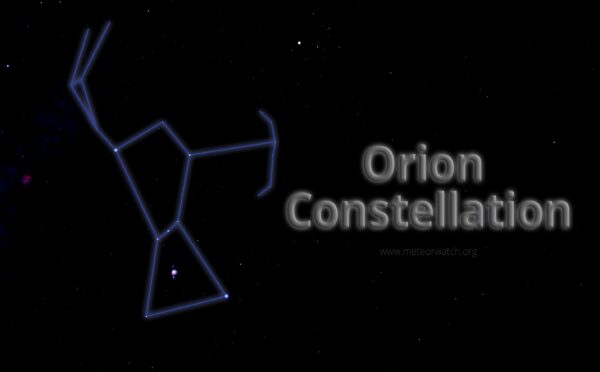
The Orion Constellation – Mighty Guardian of Winter Skies
Out of all the constellations in the night sky, one of the most well known and obvious is Orion. Anyone just looking up at the winter sky can’t help but notice this celestial wonder. Orion is probably the most striking of all the constellations. Let’s explore it some more.
Orion The Hunter
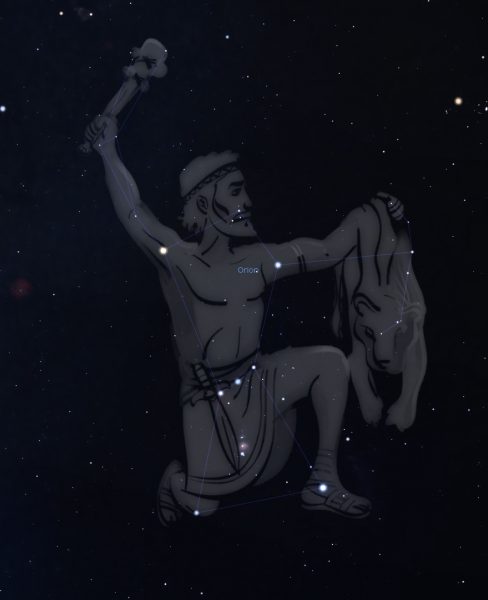
Orion the Hunter Credit: Stellarium
Orion: In Greek Mythology, Orion is a mighty hunter. The son of a Gorgon and Poseidon. Legend has it, Orion offended the goddess Gaia when he said he could kill all the animals on Earth. Because of this, the angry goddess tried to kill Orion with a scorpion, but Ophiuchus intervened and saved Orion. Consequently, this is why Orion and Scorpius – the scorpion, are at opposite sides of the sky with Ophiuchus midway between them.
The Constellation
Orion is on the celestial equator, therefore it’s pretty much visible from most of the planet. The constellation sits between and below Taurus in the West and Gemini in the east. In addition Monoceros, Canis Major, Lepus and Eridanus are on its borders. At first glance, the constellation consists of 7 bright stars forming Orion’s shoulders, waist and lower body- An hour glass asterism. Furthermore, fainter stars mark out his club above his head and outstretched arm holding a lion. In the northern hemisphere, Orion is a winter constellation.
Bright Stars

7 Brightest Stars. Credit: Stellarium
The 7 brightest stars consist of:
- Betelgeuse – (Alpha Orionis) Represents Orion’s right shoulder. A red supergiant star near the end of its life. When it explodes it will be visible in the daytime for several months. Betelgeuse is over 600 light years away so it may have exploded already. The light from the explosion may not have reached us yet.
- Rigel – (Beta Orionis) Is found at the bottom right of the 7 stars, the left foot and is a blue supergiant. Rigel is the 6th brightest star in the sky and will either end in a spectacular supernova or diminish to a white dwarf.
- Bellatrix – “The Amazon Star” A blue giant star found on the right shoulder.
- Saiph – A fainter star than the others forming the shape of the constellation and found at the right foot of Orion.
The Three Belt Stars
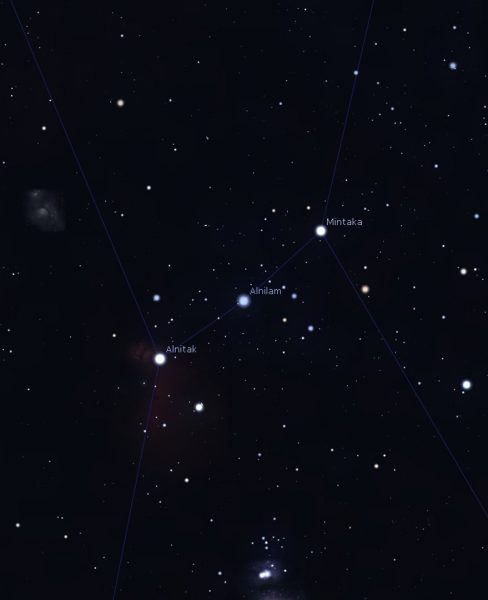
Orions Belt. Credit: Stellarium
The three central stars form the “Orions Belt” asterism and are the easiest way of identifying the constellation. Orion’s belt has featured heavily in history, from the Egyptians placing the great pyramids so they reflect the positions of the belt stars, to the films “Blade Runner” and “Men in Black”.
- Alnitak – Also known as “The Girdle”, is the easternmost star out of the trio. It is a blue supergiant approximately 800 light years away. It is the brightest O class star in the sky.
- Alnilam – Arabic meaning “String of pearls” Is the central star out of the trio. It is also a blue supergiant 1975 light years away.
- Mintaka – Also known as “The Belt”, is the westernmost star out of the three. It is a double star system approximately 900 light years away.
Head, Club and Shield Stars
In addition to the brighter stars, there are also stars that make up the rest of the constellation. Three stars form a triangle consequently marking out Orions head and stretching up from Betelgeuse are five fainter stars forming the club. The shield/ lion is comprised of 6 stars to the west of Bellatrix.
Meteor Showers
The Orionid Meteor Shower is the only meteor shower associated with the constellation. It peaks around the 20th of October every year with around 10 to 20 meteors per hour at its peak. The meteor showers origins are due to Halley’s Comet.
Deep Sky Objects
In addition to the asterisms and bright stars, Orion is a fantastic constellation for spotting deep sky objects. It is host to the most noteworthy, prominent and famous of them all: The Great Orion Nebula – M42. Easily identified with the naked eye, as a result it’s true splendour comes to life in binoculars and telescopes. A stellar nursery of gas, dust, and infant stars (as a result of being illuminated by the Trapezium) is found below the belt stars in what appears to be Orion’s sword.
Furthermore, if you have a large telescope a wealth of different objects can be found consequently, there are too many to include here. Therefore here are the more famous: Beneath the star Alnitak is “The Horsehead nebula” A massive cloud of dust in the shape of a horses head blocking light from the nebulae behind. To the left of Alnitak can be found the “Flame Nebula” NGC 2024 Lying to the north-east opposite the belt and a similar distance as the belt is long, is the much fainter M78. Similar in composition and distance to M42 but much fainter. If you have a very large telescope and take long exposure images you can pick out Barnard’s Loop, weaving its way around the constellation.
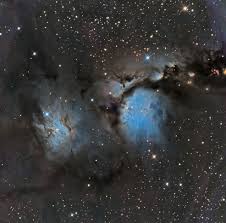
M78 Credit: NASA
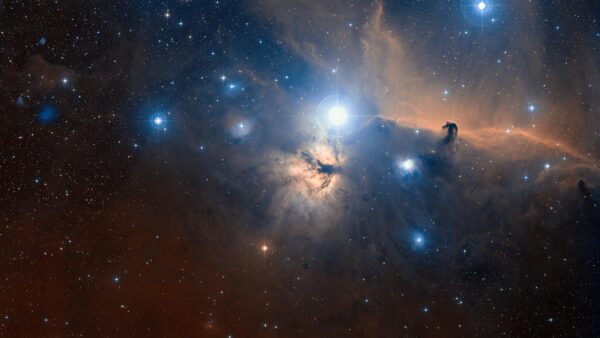
Horsehead and Flame nebula Credit: NASA
In conclusion, there is much more to explore with binoculars or a telescope in this favourite of many constellations. Explore it and see what you can see…
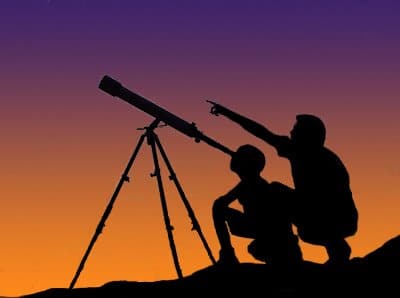
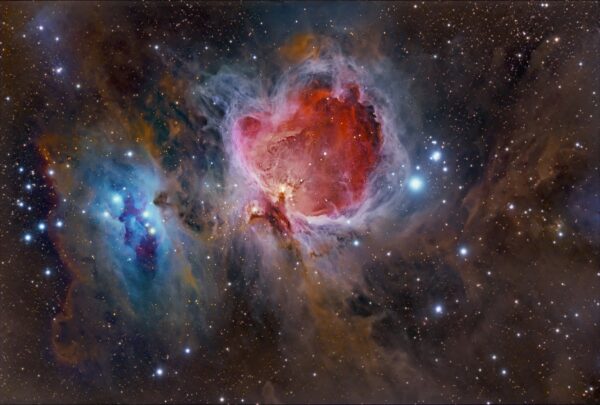
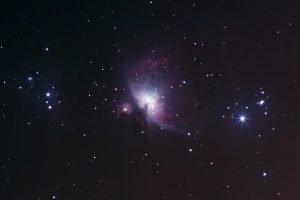
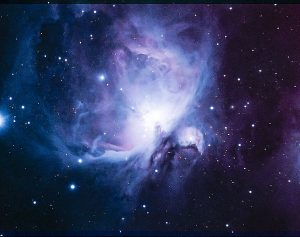
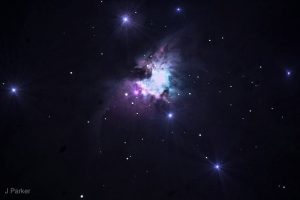
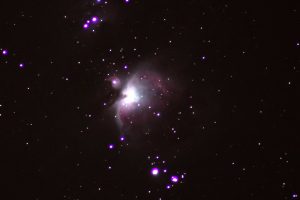



This is great info! Thank you so much. I’m off to see what I can make out!